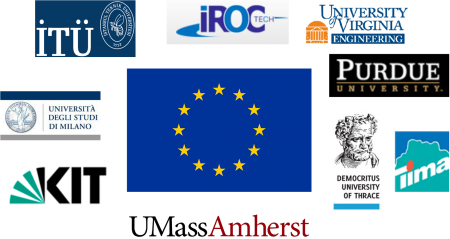Main Page
From NANOxCOMP H2020 Project
Welcome to the NANOxCOMP Project
|
|
Nano-crossbar arrays have emerged as a strong candidate technology to replace CMOS in near future. They are regular and dense structures, and fabricated by exploiting self-assembly as opposed to purely using lithography based conventional and relatively costly CMOS fabrication techniques. Currently, nano-crossbar arrays are fabricated such that each crosspoint can be used as a conventional electronic component such as a diode, a FET, or a switch. This is a unique opportunity that allows us to integrate well developed conventional circuit design techniques into nano-crossbar arrays. Motivated by this, we aim to develop a complete synthesis and performance optimization methodology for switching nano-crossbar arrays that leads to the design and construction of an emerging nanocomputer.
Project objectives are 1) synthesizing Boolean functions with area optimization; 2) achieving fault tolerance; 3) performing performance optimization by considering area, delay, power, and accuracy; 4) implementing arithmetic and memory elements; and 5) realizing a synchronous state machine.
|
Project details
| title:
|
Synthesis and Performance Optimization of a Switching Nano-Crossbar Computer
|
| acronym:
|
NANOxCOMP
|
| principal investigator / coordinator:
|
Mustafa Altun, ECC Group, Istanbul Technical University
|
| partner(s):
|
- Dr. Dan Alexandrescu, IROC Techonogies, France
- Prof. Lorena Anghel, TIMA Lab., France (partnership terminated)
- Prof. Valentina Ciriani, ALOS Lab., University of Milan, Italy.
- Prof. Csaba A. Moritz, Nanoscale Computing Fabrics Lab., University of Massachusetts, USA
- Prof. Kaushik Roy, Nanoelectronics Research Lab., Purdue University, USA
- Prof. Georgios Sirakoulis, Department of Electrical and Computer Engineering, Democritus University of Thrace, Greece (new partner)
- Prof. Mircea Stan, High-Performance Low-Power Lab., University of Virginia, USA
- Prof. Mehdi B. Tahoori, Dependable Nano-Computing Group, Karlsruhe Institute of Technology, Germany
|
| funding agency & program:
|
European Union/European Commission H2020 MSCA Research and Innovation Staff Exchange Program (RISE)
RISE Video
|
| budget:
|
724.500 EURO
|
| duration:
|
2015-2019
|
This project
- gathers globally leading research groups working on nanoelectronics and EDA;
- targets variety of emerging technologies including nanowire/nanotube crossbar arrays, magnetic switch-based structures, and crossbar memories; and
- contributes to the construction of emerging computers beyond CMOS by proposing nano-crossbar based computer architectures.
|
|
This project has received funding from the European Union's H2020 research and innovation programme under the Marie Skłodowska-Curie grant agreement No 691178.
|
|
Project by the numbers, 2015-2019
Started in 2015, the project has been successfully completed in 2019 with many achievements including:
- 1.300.000 TL/$450.000 was received to be spent for our group. $300.000 came from an EU H2020 project and $150.000 came from three different TUBITAK projects. We are the principal investigator (PI) of all these 4 projects.
- 20 peer-reviewed papers were published/accepted. 13 of them are solely made in ECC -- all authors are from our group. 4 of them are coauthored by our collaborators from industry and 5 of them are coauthored by our collaborators from academia.
- 5 Masters students graduated from our group and 5 Doctoral students joined us.
|
Project activity news
- We present our work "Nano-Crossbar based Computing: Lessons Learned and Future Directions" in a premier conference on electronic design automation DATE 2020.
- We present our work "CMOS Implementation of Switching Lattices" in a premier conference on electronic design automation DATE 2020.
- We present our work "Analog Neural Network based on Memristor Crossbar Arrays" in ELECO 2019.
- We present our work "Noise-induced Performance Enhancement of Variability-aware Memristor Networks" in ICECS 2019.
- We give a keynote talk "Computing with Nano-crossbar Arrays" in CENICS 2019.
- We present our work "Testability of Switching Lattices in the Cellular Fault Model" in DSD 2019.
- A new partner Prof. Georgios Sirakoulis from Democritus University of Thrace, Greece has joined our consortium. Welcome!
- We present our work "Realization of Four-Terminal Switching Lattices: Technology Development and Circuit Modeling" in a premier conference on electronic design automation DATE 2019.
- We present our work "A Satisfiability-Based Approximate Algorithm for Logic Synthesis Using Switching Lattices" in a premier conference on electronic design automation DATE 2019.
- We present our work "Fault Mitigation of Switching Lattices under the Stuck-At-Fault Model" in LATS 2019.
- We present our work "Testability of Switching Lattices in the Stuck at Fault Model" in VLSI-Soc 2018.
- We present our work "Integrated Synthesis Methodology for Crossbar Arrays" in a leading conference on nanocircuits/nanoarchitectures IEEE/ACM-NANOARCH 2018.
- We present our work "Logic Synthesis and Defect Tolerance for Memristive Crossbar Arrays" in a premier conference on electronic design automation DATE 2018.
- We present our work "Yield Analysis of Nano-Crossbar Arrays for Uniform and Clustered Defect Distributions" in IEEE-ICECS 2017.
- We present our work "Composition of Switching Lattices and Autosymmetric Boolean Function Synthesis" in DSD 2017.
- We present our work "Spintronic Memristor based Offset Cancellation Technique for Sense Amplifiers" in SMACD 2017.
- We successfully have our midterm review meeting in Lausanne, Switzerland on March 2017. For the agenda click here.
- We present our work "Computing with Nano-Crossbar Arrays: Logic Synthesis and Fault Tolerance" in a premier conference on electronic design automation DATE 2017.
- We present our work "Synthesis on Switching Lattices of Dimension-Reducible Boolean Functions" in VLSI-Soc 2016.
- We present our project and our work on logic synthesis of switching nanoarrays in DSD 2016.
- We present our work "Power-Delay-Area Performance Modeling and Analysis for Nano-Crossbar Arrays" in IEEE-ISVLSI 2016.
- We give an invited talk "Circuit Design and Optimization of Nano-Crossbar Arrays" in NanoTR-12.
- We give a plenary talk "Implementation of a Switching Nano-Crossbar Computer" in ACS 2016.
- We present and exhibit our EU H2020 project NANOxCOMP in a premier conference on electronic design automation DATE 2016 with over 1000 attendees from academia and industry.
|





